Strategic Analysis of Google's Business Operations
VerifiedAdded on 2023/04/22
|17
|5061
|159
Report
AI Summary
This report provides a strategic analysis of Google's business operations, examining key strategies such as diversification, strategic alliances, industry interdependence, and generic strategies like differentiation. It assesses Google's external environment, including political, economic, and technological factors, along with a Porter's Five Forces analysis to evaluate industry competitiveness. The report further explores Google's internal strategic competencies through a resource-based view and VRIO analysis, assessing strategic fit and identifying strengths, weaknesses, opportunities, and threats. It also discusses marketing warfare strategies and concludes with recommendations to address identified gaps, aiming to enhance the effectiveness of Google's existing business strategies in the global market.
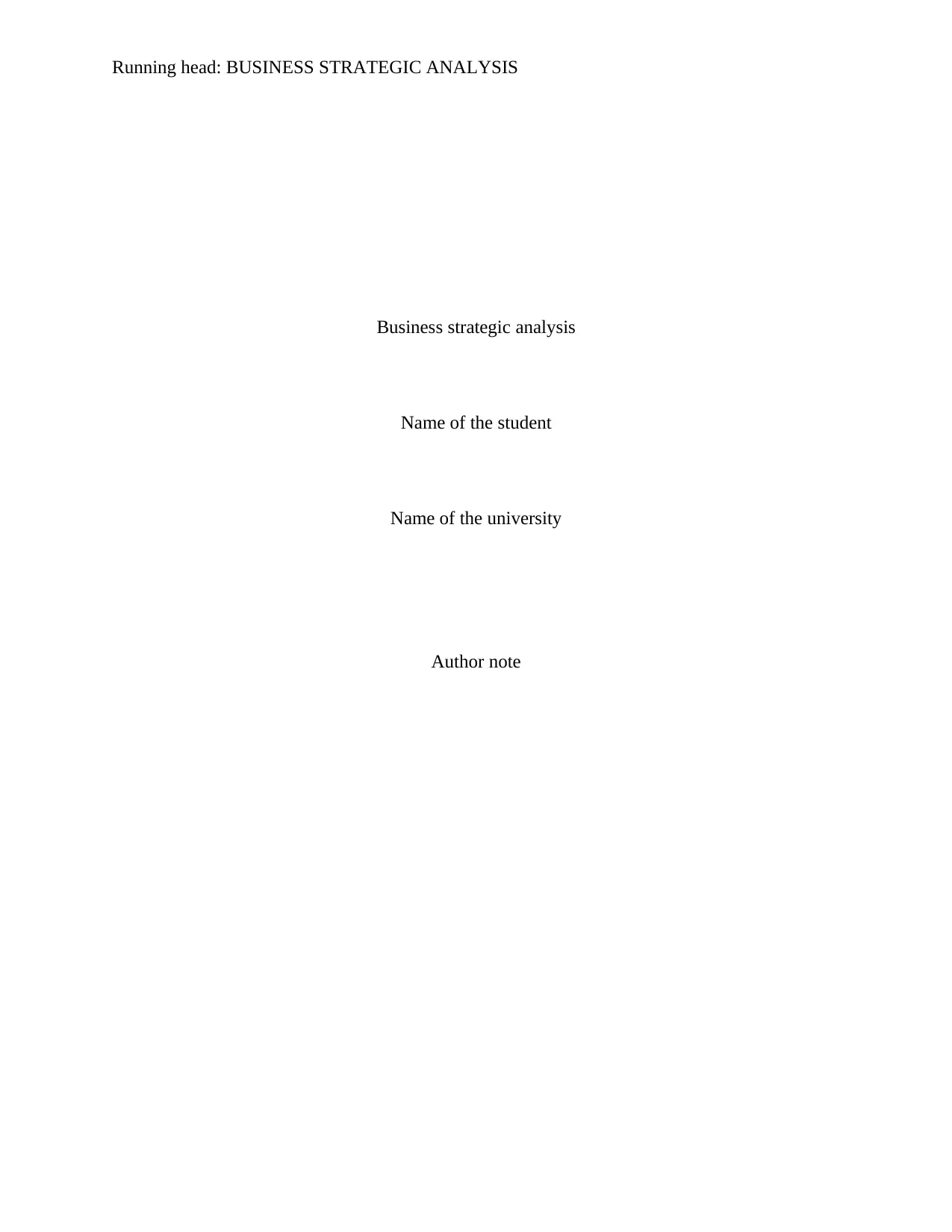
Running head: BUSINESS STRATEGIC ANALYSIS
Business strategic analysis
Name of the student
Name of the university
Author note
Business strategic analysis
Name of the student
Name of the university
Author note
Paraphrase This Document
Need a fresh take? Get an instant paraphrase of this document with our AI Paraphraser
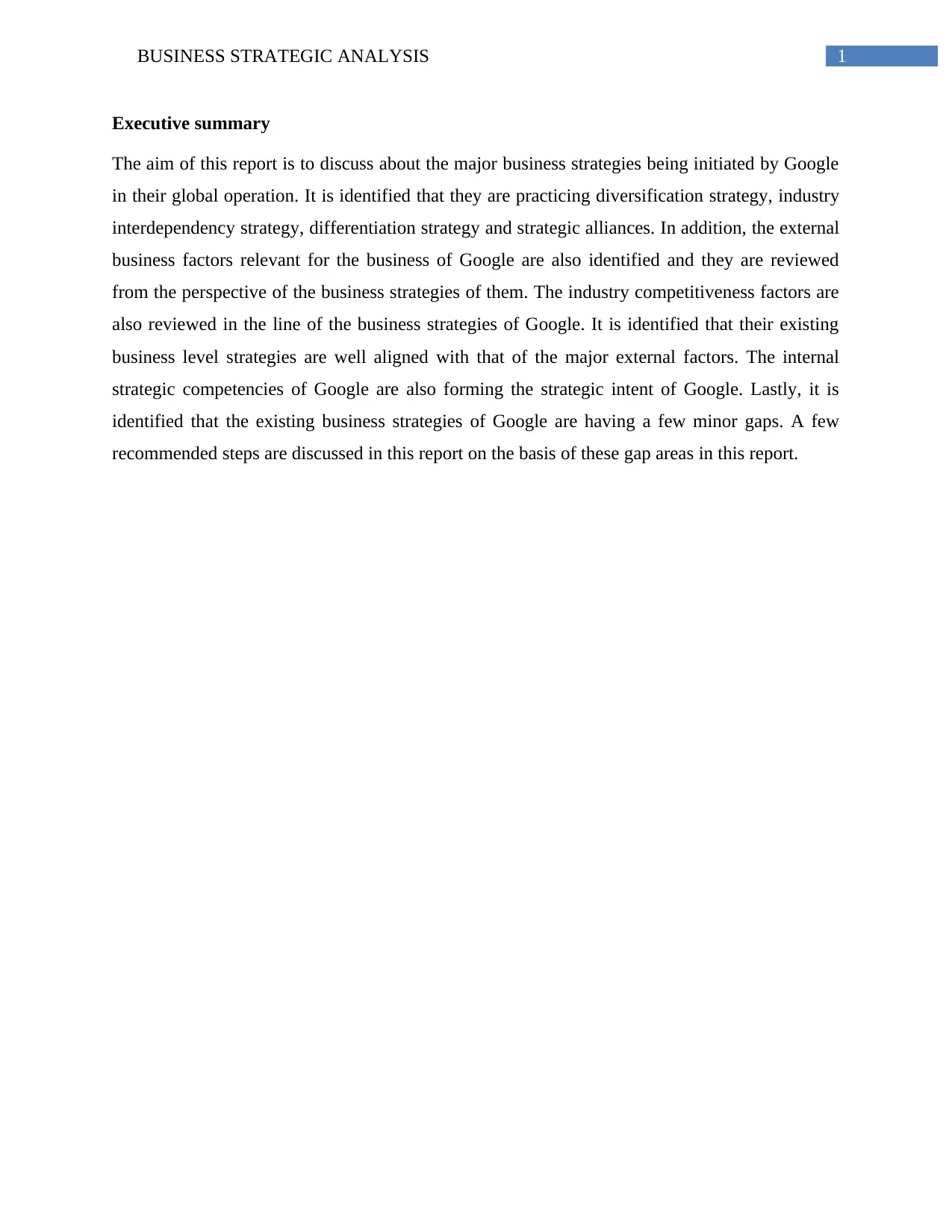
1BUSINESS STRATEGIC ANALYSIS
Executive summary
The aim of this report is to discuss about the major business strategies being initiated by Google
in their global operation. It is identified that they are practicing diversification strategy, industry
interdependency strategy, differentiation strategy and strategic alliances. In addition, the external
business factors relevant for the business of Google are also identified and they are reviewed
from the perspective of the business strategies of them. The industry competitiveness factors are
also reviewed in the line of the business strategies of Google. It is identified that their existing
business level strategies are well aligned with that of the major external factors. The internal
strategic competencies of Google are also forming the strategic intent of Google. Lastly, it is
identified that the existing business strategies of Google are having a few minor gaps. A few
recommended steps are discussed in this report on the basis of these gap areas in this report.
Executive summary
The aim of this report is to discuss about the major business strategies being initiated by Google
in their global operation. It is identified that they are practicing diversification strategy, industry
interdependency strategy, differentiation strategy and strategic alliances. In addition, the external
business factors relevant for the business of Google are also identified and they are reviewed
from the perspective of the business strategies of them. The industry competitiveness factors are
also reviewed in the line of the business strategies of Google. It is identified that their existing
business level strategies are well aligned with that of the major external factors. The internal
strategic competencies of Google are also forming the strategic intent of Google. Lastly, it is
identified that the existing business strategies of Google are having a few minor gaps. A few
recommended steps are discussed in this report on the basis of these gap areas in this report.
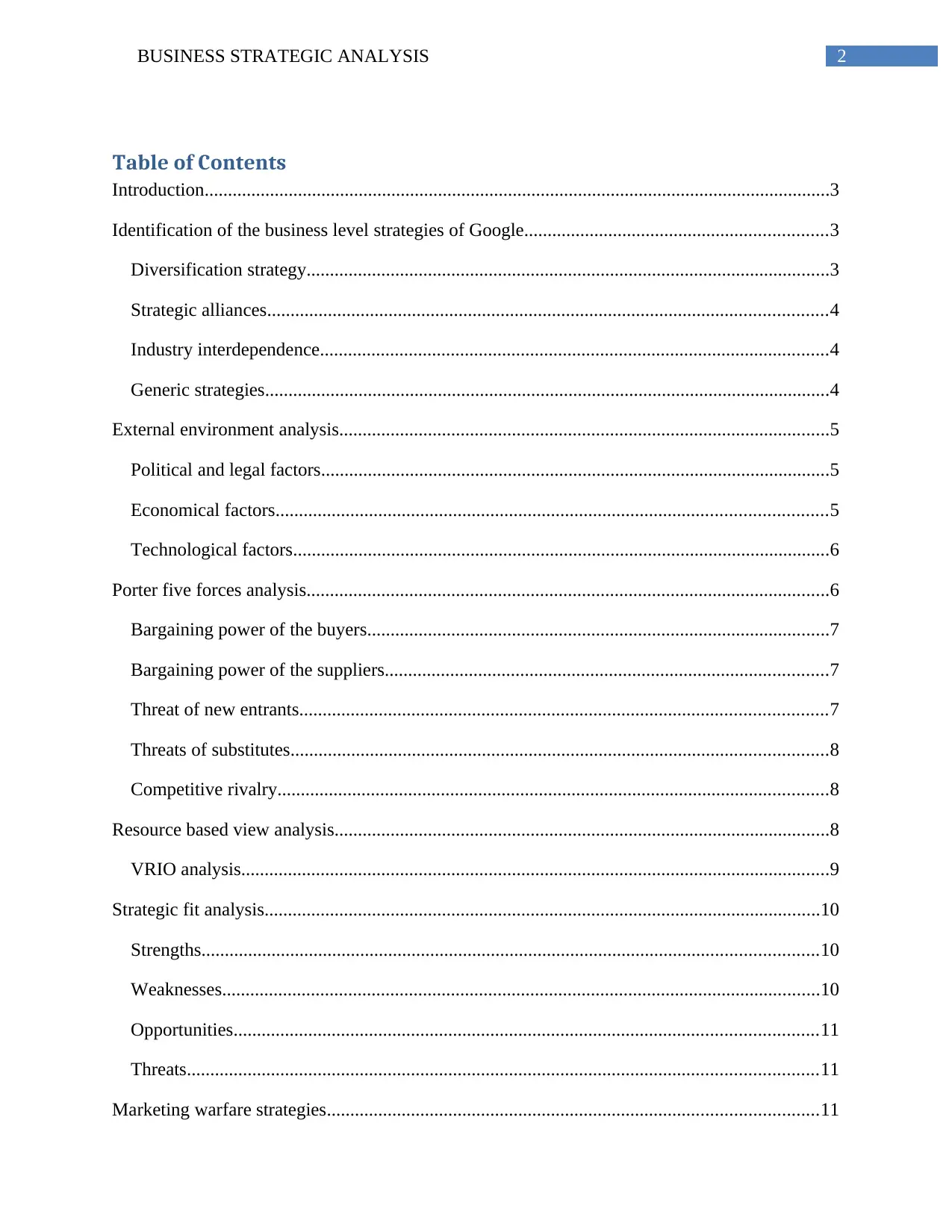
2BUSINESS STRATEGIC ANALYSIS
Table of Contents
Introduction......................................................................................................................................3
Identification of the business level strategies of Google.................................................................3
Diversification strategy................................................................................................................3
Strategic alliances........................................................................................................................4
Industry interdependence.............................................................................................................4
Generic strategies.........................................................................................................................4
External environment analysis.........................................................................................................5
Political and legal factors.............................................................................................................5
Economical factors......................................................................................................................5
Technological factors...................................................................................................................6
Porter five forces analysis................................................................................................................6
Bargaining power of the buyers...................................................................................................7
Bargaining power of the suppliers...............................................................................................7
Threat of new entrants.................................................................................................................7
Threats of substitutes...................................................................................................................8
Competitive rivalry......................................................................................................................8
Resource based view analysis..........................................................................................................8
VRIO analysis..............................................................................................................................9
Strategic fit analysis.......................................................................................................................10
Strengths....................................................................................................................................10
Weaknesses................................................................................................................................10
Opportunities.............................................................................................................................11
Threats.......................................................................................................................................11
Marketing warfare strategies.........................................................................................................11
Table of Contents
Introduction......................................................................................................................................3
Identification of the business level strategies of Google.................................................................3
Diversification strategy................................................................................................................3
Strategic alliances........................................................................................................................4
Industry interdependence.............................................................................................................4
Generic strategies.........................................................................................................................4
External environment analysis.........................................................................................................5
Political and legal factors.............................................................................................................5
Economical factors......................................................................................................................5
Technological factors...................................................................................................................6
Porter five forces analysis................................................................................................................6
Bargaining power of the buyers...................................................................................................7
Bargaining power of the suppliers...............................................................................................7
Threat of new entrants.................................................................................................................7
Threats of substitutes...................................................................................................................8
Competitive rivalry......................................................................................................................8
Resource based view analysis..........................................................................................................8
VRIO analysis..............................................................................................................................9
Strategic fit analysis.......................................................................................................................10
Strengths....................................................................................................................................10
Weaknesses................................................................................................................................10
Opportunities.............................................................................................................................11
Threats.......................................................................................................................................11
Marketing warfare strategies.........................................................................................................11
⊘ This is a preview!⊘
Do you want full access?
Subscribe today to unlock all pages.

Trusted by 1+ million students worldwide

3BUSINESS STRATEGIC ANALYSIS
Recommendations..........................................................................................................................12
Conclusion.....................................................................................................................................12
Reference.......................................................................................................................................14
Recommendations..........................................................................................................................12
Conclusion.....................................................................................................................................12
Reference.......................................................................................................................................14
Paraphrase This Document
Need a fresh take? Get an instant paraphrase of this document with our AI Paraphraser
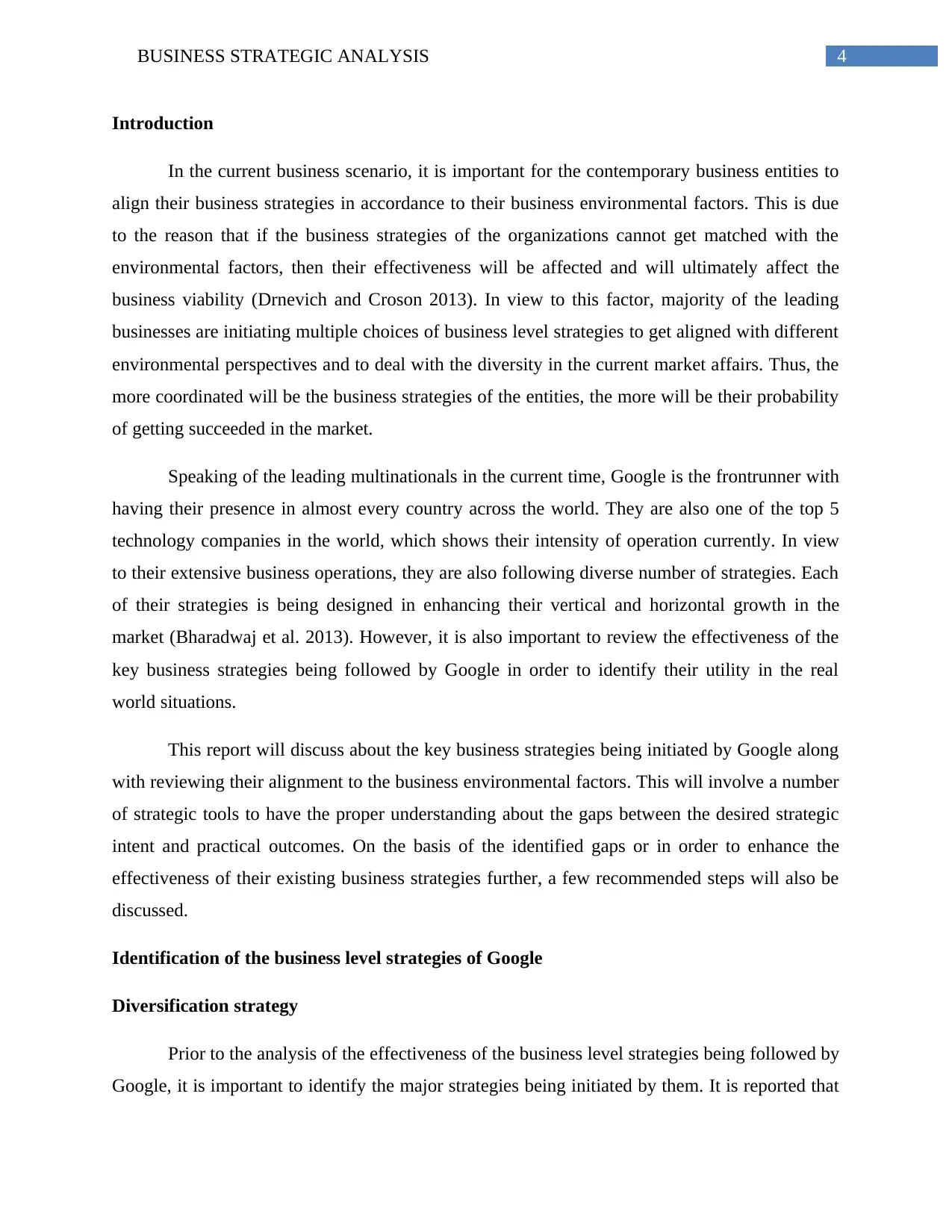
4BUSINESS STRATEGIC ANALYSIS
Introduction
In the current business scenario, it is important for the contemporary business entities to
align their business strategies in accordance to their business environmental factors. This is due
to the reason that if the business strategies of the organizations cannot get matched with the
environmental factors, then their effectiveness will be affected and will ultimately affect the
business viability (Drnevich and Croson 2013). In view to this factor, majority of the leading
businesses are initiating multiple choices of business level strategies to get aligned with different
environmental perspectives and to deal with the diversity in the current market affairs. Thus, the
more coordinated will be the business strategies of the entities, the more will be their probability
of getting succeeded in the market.
Speaking of the leading multinationals in the current time, Google is the frontrunner with
having their presence in almost every country across the world. They are also one of the top 5
technology companies in the world, which shows their intensity of operation currently. In view
to their extensive business operations, they are also following diverse number of strategies. Each
of their strategies is being designed in enhancing their vertical and horizontal growth in the
market (Bharadwaj et al. 2013). However, it is also important to review the effectiveness of the
key business strategies being followed by Google in order to identify their utility in the real
world situations.
This report will discuss about the key business strategies being initiated by Google along
with reviewing their alignment to the business environmental factors. This will involve a number
of strategic tools to have the proper understanding about the gaps between the desired strategic
intent and practical outcomes. On the basis of the identified gaps or in order to enhance the
effectiveness of their existing business strategies further, a few recommended steps will also be
discussed.
Identification of the business level strategies of Google
Diversification strategy
Prior to the analysis of the effectiveness of the business level strategies being followed by
Google, it is important to identify the major strategies being initiated by them. It is reported that
Introduction
In the current business scenario, it is important for the contemporary business entities to
align their business strategies in accordance to their business environmental factors. This is due
to the reason that if the business strategies of the organizations cannot get matched with the
environmental factors, then their effectiveness will be affected and will ultimately affect the
business viability (Drnevich and Croson 2013). In view to this factor, majority of the leading
businesses are initiating multiple choices of business level strategies to get aligned with different
environmental perspectives and to deal with the diversity in the current market affairs. Thus, the
more coordinated will be the business strategies of the entities, the more will be their probability
of getting succeeded in the market.
Speaking of the leading multinationals in the current time, Google is the frontrunner with
having their presence in almost every country across the world. They are also one of the top 5
technology companies in the world, which shows their intensity of operation currently. In view
to their extensive business operations, they are also following diverse number of strategies. Each
of their strategies is being designed in enhancing their vertical and horizontal growth in the
market (Bharadwaj et al. 2013). However, it is also important to review the effectiveness of the
key business strategies being followed by Google in order to identify their utility in the real
world situations.
This report will discuss about the key business strategies being initiated by Google along
with reviewing their alignment to the business environmental factors. This will involve a number
of strategic tools to have the proper understanding about the gaps between the desired strategic
intent and practical outcomes. On the basis of the identified gaps or in order to enhance the
effectiveness of their existing business strategies further, a few recommended steps will also be
discussed.
Identification of the business level strategies of Google
Diversification strategy
Prior to the analysis of the effectiveness of the business level strategies being followed by
Google, it is important to identify the major strategies being initiated by them. It is reported that
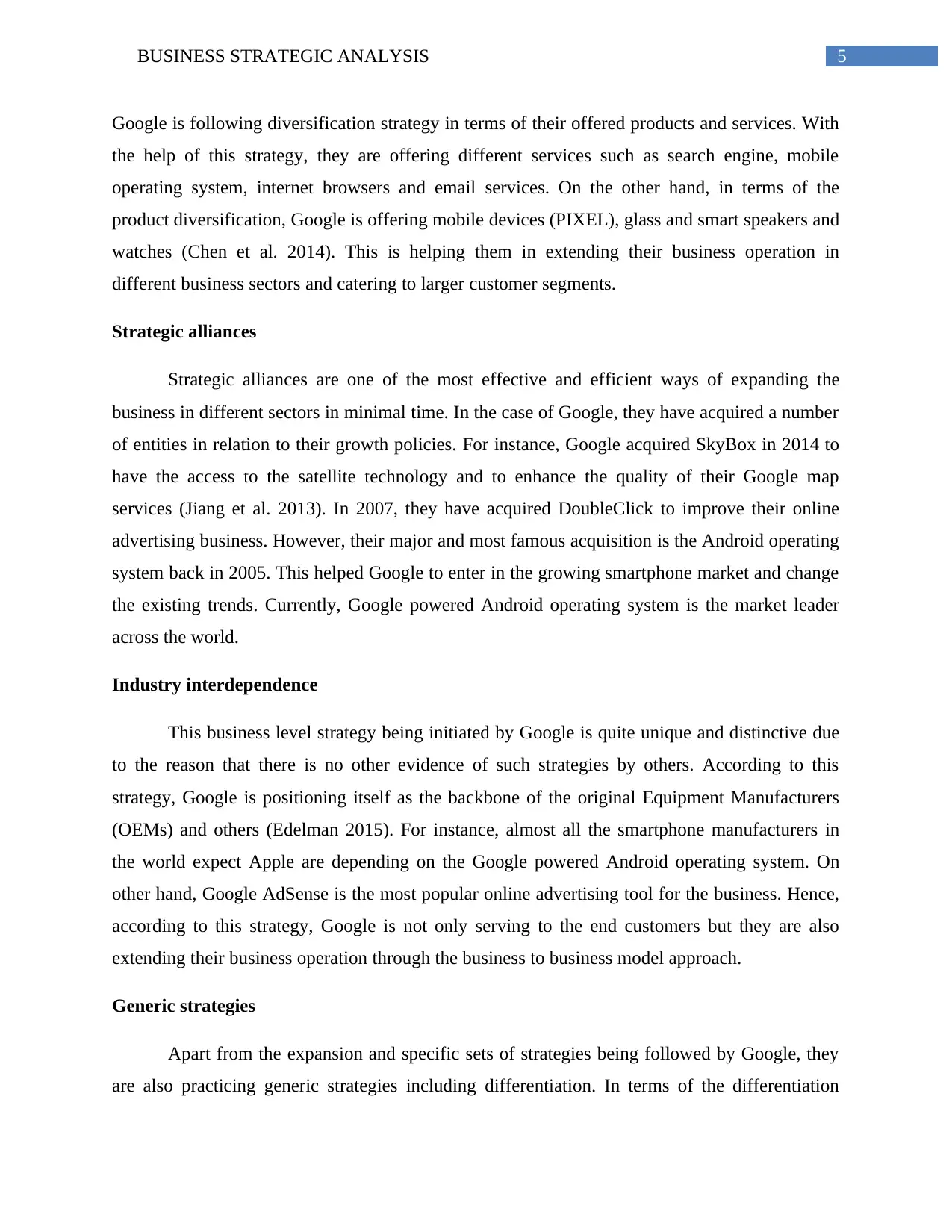
5BUSINESS STRATEGIC ANALYSIS
Google is following diversification strategy in terms of their offered products and services. With
the help of this strategy, they are offering different services such as search engine, mobile
operating system, internet browsers and email services. On the other hand, in terms of the
product diversification, Google is offering mobile devices (PIXEL), glass and smart speakers and
watches (Chen et al. 2014). This is helping them in extending their business operation in
different business sectors and catering to larger customer segments.
Strategic alliances
Strategic alliances are one of the most effective and efficient ways of expanding the
business in different sectors in minimal time. In the case of Google, they have acquired a number
of entities in relation to their growth policies. For instance, Google acquired SkyBox in 2014 to
have the access to the satellite technology and to enhance the quality of their Google map
services (Jiang et al. 2013). In 2007, they have acquired DoubleClick to improve their online
advertising business. However, their major and most famous acquisition is the Android operating
system back in 2005. This helped Google to enter in the growing smartphone market and change
the existing trends. Currently, Google powered Android operating system is the market leader
across the world.
Industry interdependence
This business level strategy being initiated by Google is quite unique and distinctive due
to the reason that there is no other evidence of such strategies by others. According to this
strategy, Google is positioning itself as the backbone of the original Equipment Manufacturers
(OEMs) and others (Edelman 2015). For instance, almost all the smartphone manufacturers in
the world expect Apple are depending on the Google powered Android operating system. On
other hand, Google AdSense is the most popular online advertising tool for the business. Hence,
according to this strategy, Google is not only serving to the end customers but they are also
extending their business operation through the business to business model approach.
Generic strategies
Apart from the expansion and specific sets of strategies being followed by Google, they
are also practicing generic strategies including differentiation. In terms of the differentiation
Google is following diversification strategy in terms of their offered products and services. With
the help of this strategy, they are offering different services such as search engine, mobile
operating system, internet browsers and email services. On the other hand, in terms of the
product diversification, Google is offering mobile devices (PIXEL), glass and smart speakers and
watches (Chen et al. 2014). This is helping them in extending their business operation in
different business sectors and catering to larger customer segments.
Strategic alliances
Strategic alliances are one of the most effective and efficient ways of expanding the
business in different sectors in minimal time. In the case of Google, they have acquired a number
of entities in relation to their growth policies. For instance, Google acquired SkyBox in 2014 to
have the access to the satellite technology and to enhance the quality of their Google map
services (Jiang et al. 2013). In 2007, they have acquired DoubleClick to improve their online
advertising business. However, their major and most famous acquisition is the Android operating
system back in 2005. This helped Google to enter in the growing smartphone market and change
the existing trends. Currently, Google powered Android operating system is the market leader
across the world.
Industry interdependence
This business level strategy being initiated by Google is quite unique and distinctive due
to the reason that there is no other evidence of such strategies by others. According to this
strategy, Google is positioning itself as the backbone of the original Equipment Manufacturers
(OEMs) and others (Edelman 2015). For instance, almost all the smartphone manufacturers in
the world expect Apple are depending on the Google powered Android operating system. On
other hand, Google AdSense is the most popular online advertising tool for the business. Hence,
according to this strategy, Google is not only serving to the end customers but they are also
extending their business operation through the business to business model approach.
Generic strategies
Apart from the expansion and specific sets of strategies being followed by Google, they
are also practicing generic strategies including differentiation. In terms of the differentiation
⊘ This is a preview!⊘
Do you want full access?
Subscribe today to unlock all pages.

Trusted by 1+ million students worldwide
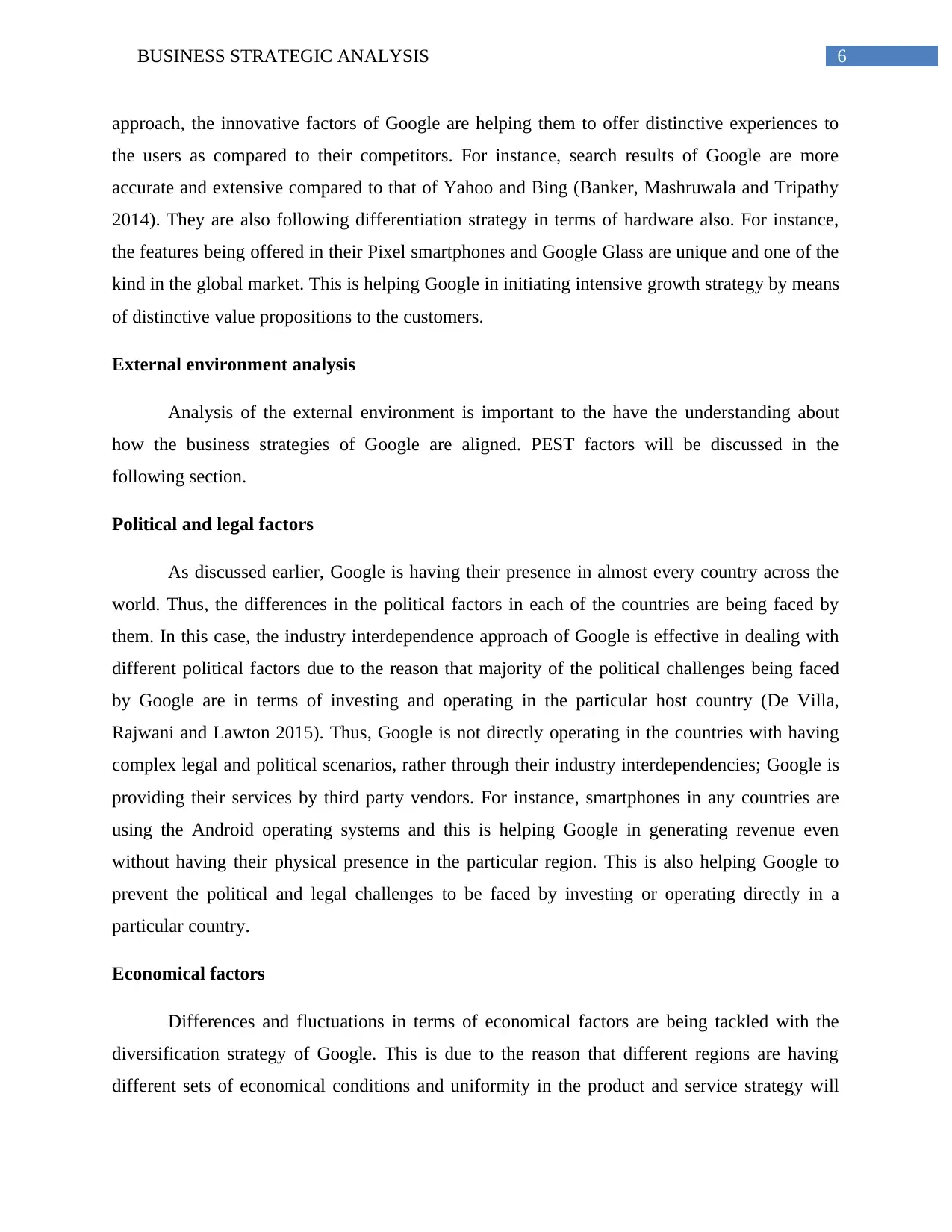
6BUSINESS STRATEGIC ANALYSIS
approach, the innovative factors of Google are helping them to offer distinctive experiences to
the users as compared to their competitors. For instance, search results of Google are more
accurate and extensive compared to that of Yahoo and Bing (Banker, Mashruwala and Tripathy
2014). They are also following differentiation strategy in terms of hardware also. For instance,
the features being offered in their Pixel smartphones and Google Glass are unique and one of the
kind in the global market. This is helping Google in initiating intensive growth strategy by means
of distinctive value propositions to the customers.
External environment analysis
Analysis of the external environment is important to the have the understanding about
how the business strategies of Google are aligned. PEST factors will be discussed in the
following section.
Political and legal factors
As discussed earlier, Google is having their presence in almost every country across the
world. Thus, the differences in the political factors in each of the countries are being faced by
them. In this case, the industry interdependence approach of Google is effective in dealing with
different political factors due to the reason that majority of the political challenges being faced
by Google are in terms of investing and operating in the particular host country (De Villa,
Rajwani and Lawton 2015). Thus, Google is not directly operating in the countries with having
complex legal and political scenarios, rather through their industry interdependencies; Google is
providing their services by third party vendors. For instance, smartphones in any countries are
using the Android operating systems and this is helping Google in generating revenue even
without having their physical presence in the particular region. This is also helping Google to
prevent the political and legal challenges to be faced by investing or operating directly in a
particular country.
Economical factors
Differences and fluctuations in terms of economical factors are being tackled with the
diversification strategy of Google. This is due to the reason that different regions are having
different sets of economical conditions and uniformity in the product and service strategy will
approach, the innovative factors of Google are helping them to offer distinctive experiences to
the users as compared to their competitors. For instance, search results of Google are more
accurate and extensive compared to that of Yahoo and Bing (Banker, Mashruwala and Tripathy
2014). They are also following differentiation strategy in terms of hardware also. For instance,
the features being offered in their Pixel smartphones and Google Glass are unique and one of the
kind in the global market. This is helping Google in initiating intensive growth strategy by means
of distinctive value propositions to the customers.
External environment analysis
Analysis of the external environment is important to the have the understanding about
how the business strategies of Google are aligned. PEST factors will be discussed in the
following section.
Political and legal factors
As discussed earlier, Google is having their presence in almost every country across the
world. Thus, the differences in the political factors in each of the countries are being faced by
them. In this case, the industry interdependence approach of Google is effective in dealing with
different political factors due to the reason that majority of the political challenges being faced
by Google are in terms of investing and operating in the particular host country (De Villa,
Rajwani and Lawton 2015). Thus, Google is not directly operating in the countries with having
complex legal and political scenarios, rather through their industry interdependencies; Google is
providing their services by third party vendors. For instance, smartphones in any countries are
using the Android operating systems and this is helping Google in generating revenue even
without having their physical presence in the particular region. This is also helping Google to
prevent the political and legal challenges to be faced by investing or operating directly in a
particular country.
Economical factors
Differences and fluctuations in terms of economical factors are being tackled with the
diversification strategy of Google. This is due to the reason that different regions are having
different sets of economical conditions and uniformity in the product and service strategy will
Paraphrase This Document
Need a fresh take? Get an instant paraphrase of this document with our AI Paraphraser
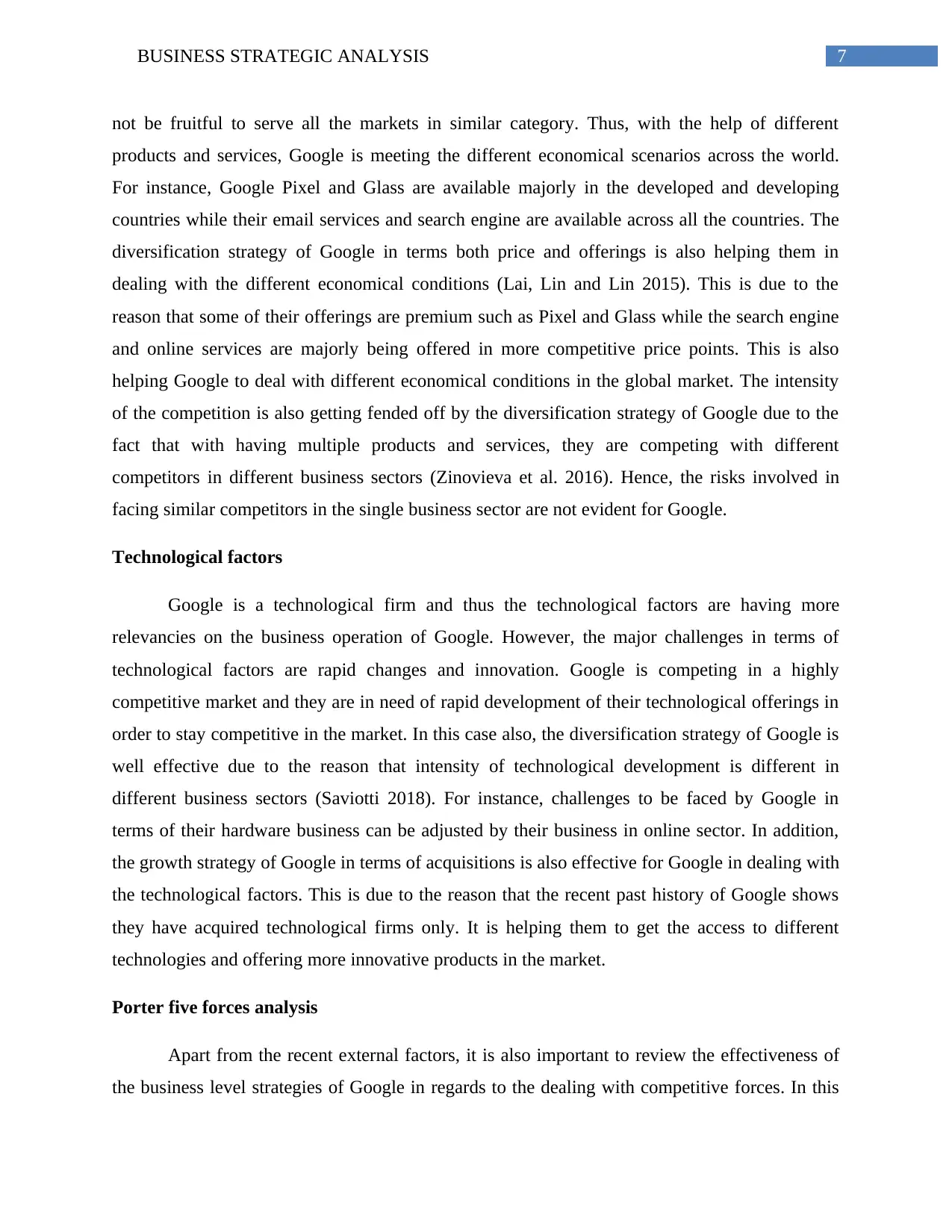
7BUSINESS STRATEGIC ANALYSIS
not be fruitful to serve all the markets in similar category. Thus, with the help of different
products and services, Google is meeting the different economical scenarios across the world.
For instance, Google Pixel and Glass are available majorly in the developed and developing
countries while their email services and search engine are available across all the countries. The
diversification strategy of Google in terms both price and offerings is also helping them in
dealing with the different economical conditions (Lai, Lin and Lin 2015). This is due to the
reason that some of their offerings are premium such as Pixel and Glass while the search engine
and online services are majorly being offered in more competitive price points. This is also
helping Google to deal with different economical conditions in the global market. The intensity
of the competition is also getting fended off by the diversification strategy of Google due to the
fact that with having multiple products and services, they are competing with different
competitors in different business sectors (Zinovieva et al. 2016). Hence, the risks involved in
facing similar competitors in the single business sector are not evident for Google.
Technological factors
Google is a technological firm and thus the technological factors are having more
relevancies on the business operation of Google. However, the major challenges in terms of
technological factors are rapid changes and innovation. Google is competing in a highly
competitive market and they are in need of rapid development of their technological offerings in
order to stay competitive in the market. In this case also, the diversification strategy of Google is
well effective due to the reason that intensity of technological development is different in
different business sectors (Saviotti 2018). For instance, challenges to be faced by Google in
terms of their hardware business can be adjusted by their business in online sector. In addition,
the growth strategy of Google in terms of acquisitions is also effective for Google in dealing with
the technological factors. This is due to the reason that the recent past history of Google shows
they have acquired technological firms only. It is helping them to get the access to different
technologies and offering more innovative products in the market.
Porter five forces analysis
Apart from the recent external factors, it is also important to review the effectiveness of
the business level strategies of Google in regards to the dealing with competitive forces. In this
not be fruitful to serve all the markets in similar category. Thus, with the help of different
products and services, Google is meeting the different economical scenarios across the world.
For instance, Google Pixel and Glass are available majorly in the developed and developing
countries while their email services and search engine are available across all the countries. The
diversification strategy of Google in terms both price and offerings is also helping them in
dealing with the different economical conditions (Lai, Lin and Lin 2015). This is due to the
reason that some of their offerings are premium such as Pixel and Glass while the search engine
and online services are majorly being offered in more competitive price points. This is also
helping Google to deal with different economical conditions in the global market. The intensity
of the competition is also getting fended off by the diversification strategy of Google due to the
fact that with having multiple products and services, they are competing with different
competitors in different business sectors (Zinovieva et al. 2016). Hence, the risks involved in
facing similar competitors in the single business sector are not evident for Google.
Technological factors
Google is a technological firm and thus the technological factors are having more
relevancies on the business operation of Google. However, the major challenges in terms of
technological factors are rapid changes and innovation. Google is competing in a highly
competitive market and they are in need of rapid development of their technological offerings in
order to stay competitive in the market. In this case also, the diversification strategy of Google is
well effective due to the reason that intensity of technological development is different in
different business sectors (Saviotti 2018). For instance, challenges to be faced by Google in
terms of their hardware business can be adjusted by their business in online sector. In addition,
the growth strategy of Google in terms of acquisitions is also effective for Google in dealing with
the technological factors. This is due to the reason that the recent past history of Google shows
they have acquired technological firms only. It is helping them to get the access to different
technologies and offering more innovative products in the market.
Porter five forces analysis
Apart from the recent external factors, it is also important to review the effectiveness of
the business level strategies of Google in regards to the dealing with competitive forces. In this
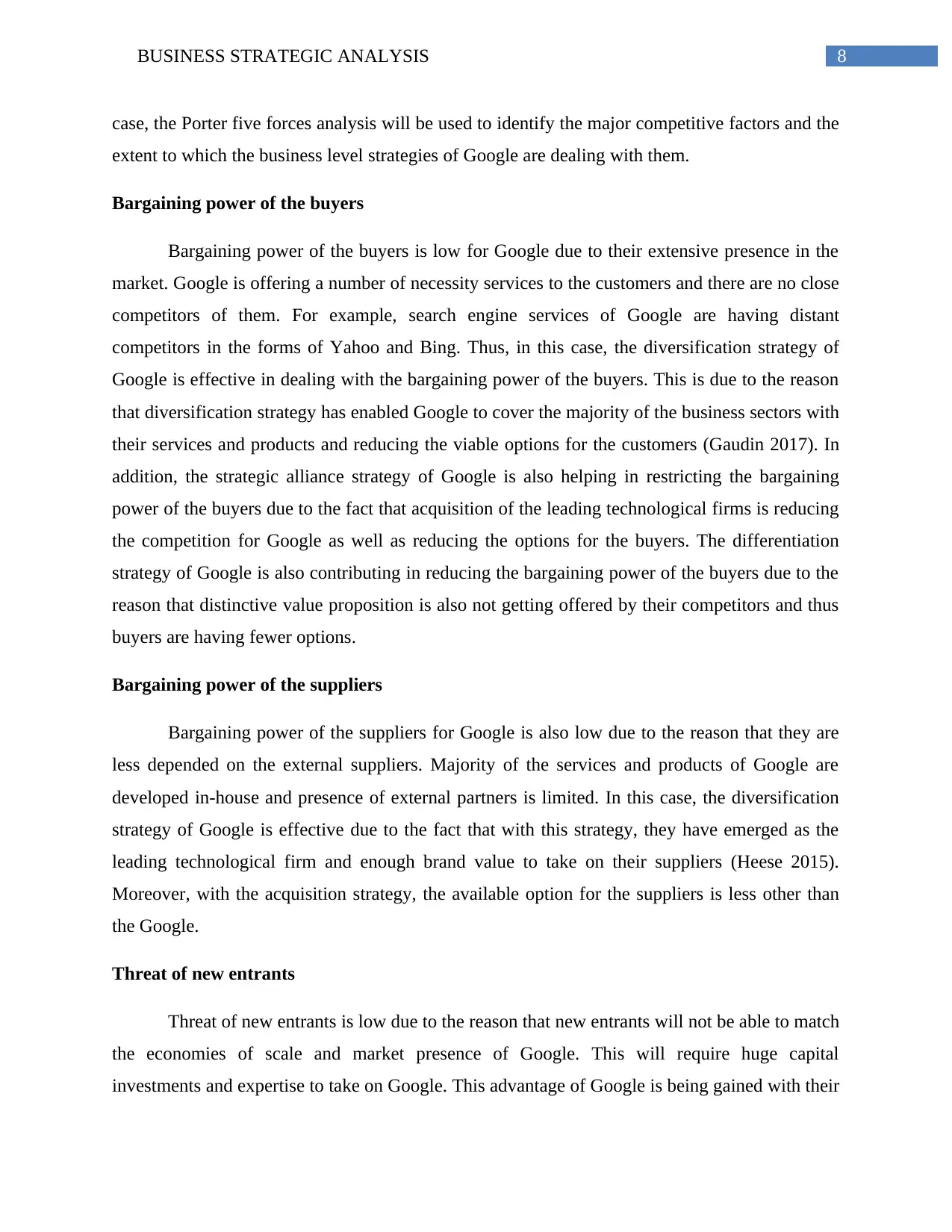
8BUSINESS STRATEGIC ANALYSIS
case, the Porter five forces analysis will be used to identify the major competitive factors and the
extent to which the business level strategies of Google are dealing with them.
Bargaining power of the buyers
Bargaining power of the buyers is low for Google due to their extensive presence in the
market. Google is offering a number of necessity services to the customers and there are no close
competitors of them. For example, search engine services of Google are having distant
competitors in the forms of Yahoo and Bing. Thus, in this case, the diversification strategy of
Google is effective in dealing with the bargaining power of the buyers. This is due to the reason
that diversification strategy has enabled Google to cover the majority of the business sectors with
their services and products and reducing the viable options for the customers (Gaudin 2017). In
addition, the strategic alliance strategy of Google is also helping in restricting the bargaining
power of the buyers due to the fact that acquisition of the leading technological firms is reducing
the competition for Google as well as reducing the options for the buyers. The differentiation
strategy of Google is also contributing in reducing the bargaining power of the buyers due to the
reason that distinctive value proposition is also not getting offered by their competitors and thus
buyers are having fewer options.
Bargaining power of the suppliers
Bargaining power of the suppliers for Google is also low due to the reason that they are
less depended on the external suppliers. Majority of the services and products of Google are
developed in-house and presence of external partners is limited. In this case, the diversification
strategy of Google is effective due to the fact that with this strategy, they have emerged as the
leading technological firm and enough brand value to take on their suppliers (Heese 2015).
Moreover, with the acquisition strategy, the available option for the suppliers is less other than
the Google.
Threat of new entrants
Threat of new entrants is low due to the reason that new entrants will not be able to match
the economies of scale and market presence of Google. This will require huge capital
investments and expertise to take on Google. This advantage of Google is being gained with their
case, the Porter five forces analysis will be used to identify the major competitive factors and the
extent to which the business level strategies of Google are dealing with them.
Bargaining power of the buyers
Bargaining power of the buyers is low for Google due to their extensive presence in the
market. Google is offering a number of necessity services to the customers and there are no close
competitors of them. For example, search engine services of Google are having distant
competitors in the forms of Yahoo and Bing. Thus, in this case, the diversification strategy of
Google is effective in dealing with the bargaining power of the buyers. This is due to the reason
that diversification strategy has enabled Google to cover the majority of the business sectors with
their services and products and reducing the viable options for the customers (Gaudin 2017). In
addition, the strategic alliance strategy of Google is also helping in restricting the bargaining
power of the buyers due to the fact that acquisition of the leading technological firms is reducing
the competition for Google as well as reducing the options for the buyers. The differentiation
strategy of Google is also contributing in reducing the bargaining power of the buyers due to the
reason that distinctive value proposition is also not getting offered by their competitors and thus
buyers are having fewer options.
Bargaining power of the suppliers
Bargaining power of the suppliers for Google is also low due to the reason that they are
less depended on the external suppliers. Majority of the services and products of Google are
developed in-house and presence of external partners is limited. In this case, the diversification
strategy of Google is effective due to the fact that with this strategy, they have emerged as the
leading technological firm and enough brand value to take on their suppliers (Heese 2015).
Moreover, with the acquisition strategy, the available option for the suppliers is less other than
the Google.
Threat of new entrants
Threat of new entrants is low due to the reason that new entrants will not be able to match
the economies of scale and market presence of Google. This will require huge capital
investments and expertise to take on Google. This advantage of Google is being gained with their
⊘ This is a preview!⊘
Do you want full access?
Subscribe today to unlock all pages.

Trusted by 1+ million students worldwide
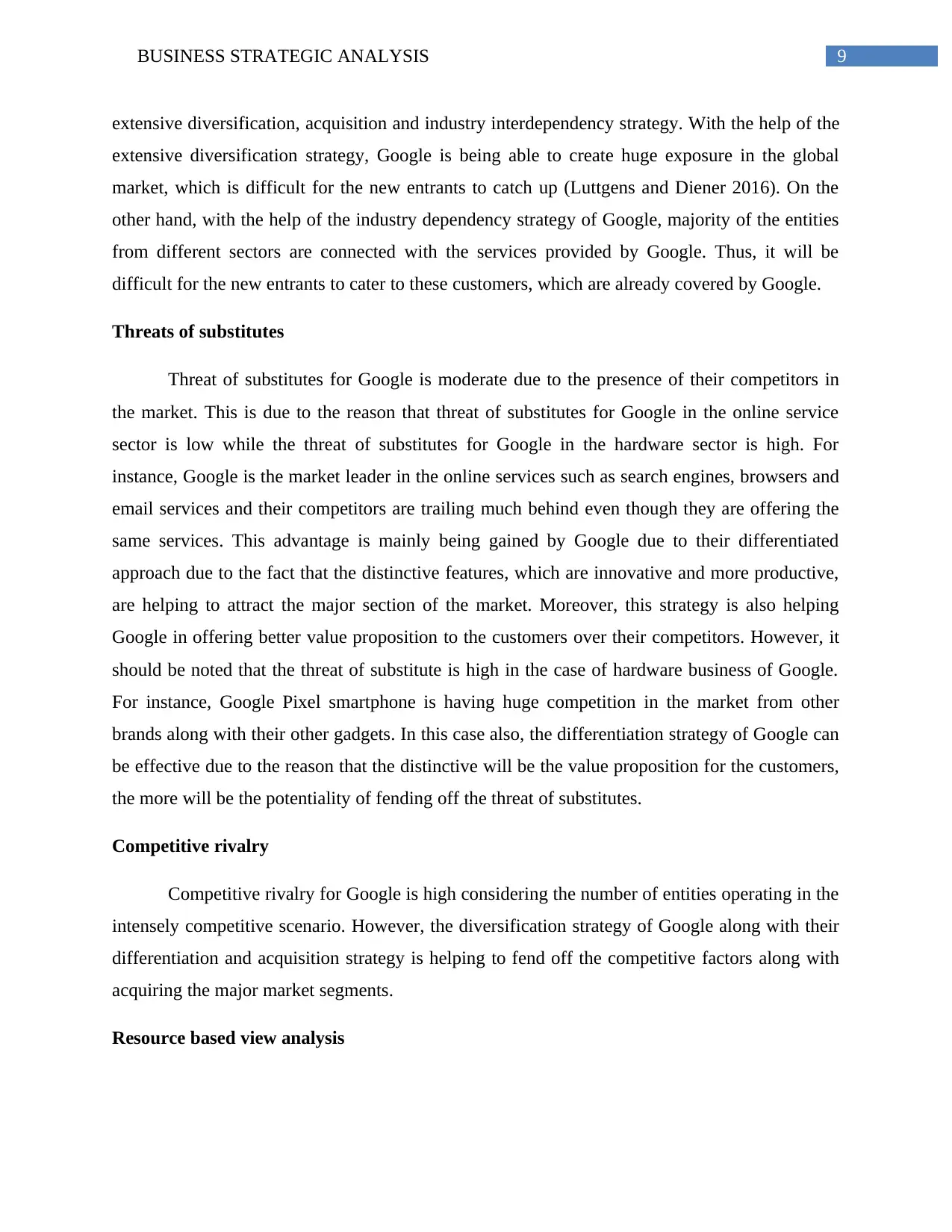
9BUSINESS STRATEGIC ANALYSIS
extensive diversification, acquisition and industry interdependency strategy. With the help of the
extensive diversification strategy, Google is being able to create huge exposure in the global
market, which is difficult for the new entrants to catch up (Luttgens and Diener 2016). On the
other hand, with the help of the industry dependency strategy of Google, majority of the entities
from different sectors are connected with the services provided by Google. Thus, it will be
difficult for the new entrants to cater to these customers, which are already covered by Google.
Threats of substitutes
Threat of substitutes for Google is moderate due to the presence of their competitors in
the market. This is due to the reason that threat of substitutes for Google in the online service
sector is low while the threat of substitutes for Google in the hardware sector is high. For
instance, Google is the market leader in the online services such as search engines, browsers and
email services and their competitors are trailing much behind even though they are offering the
same services. This advantage is mainly being gained by Google due to their differentiated
approach due to the fact that the distinctive features, which are innovative and more productive,
are helping to attract the major section of the market. Moreover, this strategy is also helping
Google in offering better value proposition to the customers over their competitors. However, it
should be noted that the threat of substitute is high in the case of hardware business of Google.
For instance, Google Pixel smartphone is having huge competition in the market from other
brands along with their other gadgets. In this case also, the differentiation strategy of Google can
be effective due to the reason that the distinctive will be the value proposition for the customers,
the more will be the potentiality of fending off the threat of substitutes.
Competitive rivalry
Competitive rivalry for Google is high considering the number of entities operating in the
intensely competitive scenario. However, the diversification strategy of Google along with their
differentiation and acquisition strategy is helping to fend off the competitive factors along with
acquiring the major market segments.
Resource based view analysis
extensive diversification, acquisition and industry interdependency strategy. With the help of the
extensive diversification strategy, Google is being able to create huge exposure in the global
market, which is difficult for the new entrants to catch up (Luttgens and Diener 2016). On the
other hand, with the help of the industry dependency strategy of Google, majority of the entities
from different sectors are connected with the services provided by Google. Thus, it will be
difficult for the new entrants to cater to these customers, which are already covered by Google.
Threats of substitutes
Threat of substitutes for Google is moderate due to the presence of their competitors in
the market. This is due to the reason that threat of substitutes for Google in the online service
sector is low while the threat of substitutes for Google in the hardware sector is high. For
instance, Google is the market leader in the online services such as search engines, browsers and
email services and their competitors are trailing much behind even though they are offering the
same services. This advantage is mainly being gained by Google due to their differentiated
approach due to the fact that the distinctive features, which are innovative and more productive,
are helping to attract the major section of the market. Moreover, this strategy is also helping
Google in offering better value proposition to the customers over their competitors. However, it
should be noted that the threat of substitute is high in the case of hardware business of Google.
For instance, Google Pixel smartphone is having huge competition in the market from other
brands along with their other gadgets. In this case also, the differentiation strategy of Google can
be effective due to the reason that the distinctive will be the value proposition for the customers,
the more will be the potentiality of fending off the threat of substitutes.
Competitive rivalry
Competitive rivalry for Google is high considering the number of entities operating in the
intensely competitive scenario. However, the diversification strategy of Google along with their
differentiation and acquisition strategy is helping to fend off the competitive factors along with
acquiring the major market segments.
Resource based view analysis
Paraphrase This Document
Need a fresh take? Get an instant paraphrase of this document with our AI Paraphraser
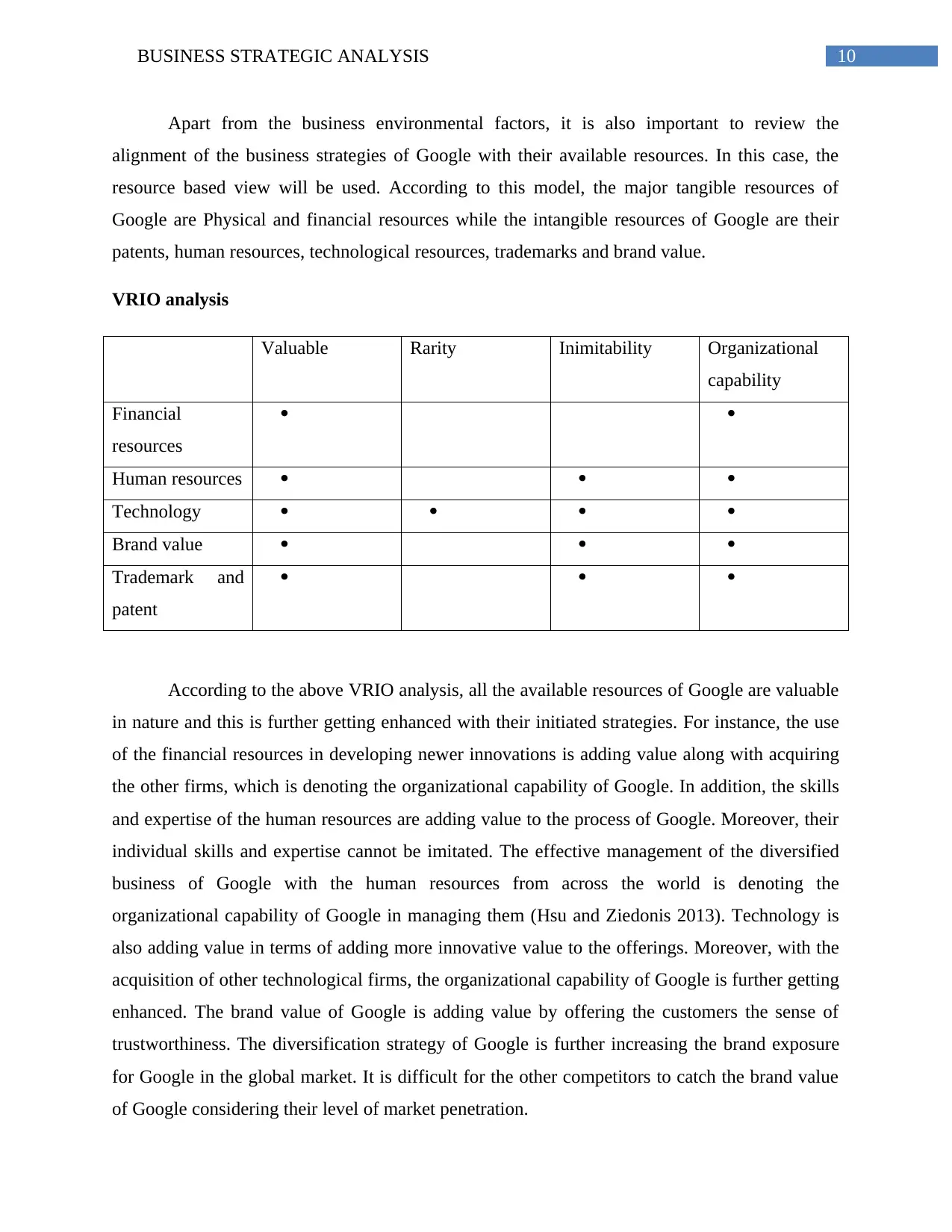
10BUSINESS STRATEGIC ANALYSIS
Apart from the business environmental factors, it is also important to review the
alignment of the business strategies of Google with their available resources. In this case, the
resource based view will be used. According to this model, the major tangible resources of
Google are Physical and financial resources while the intangible resources of Google are their
patents, human resources, technological resources, trademarks and brand value.
VRIO analysis
Valuable Rarity Inimitability Organizational
capability
Financial
resources
Human resources
Technology
Brand value
Trademark and
patent
According to the above VRIO analysis, all the available resources of Google are valuable
in nature and this is further getting enhanced with their initiated strategies. For instance, the use
of the financial resources in developing newer innovations is adding value along with acquiring
the other firms, which is denoting the organizational capability of Google. In addition, the skills
and expertise of the human resources are adding value to the process of Google. Moreover, their
individual skills and expertise cannot be imitated. The effective management of the diversified
business of Google with the human resources from across the world is denoting the
organizational capability of Google in managing them (Hsu and Ziedonis 2013). Technology is
also adding value in terms of adding more innovative value to the offerings. Moreover, with the
acquisition of other technological firms, the organizational capability of Google is further getting
enhanced. The brand value of Google is adding value by offering the customers the sense of
trustworthiness. The diversification strategy of Google is further increasing the brand exposure
for Google in the global market. It is difficult for the other competitors to catch the brand value
of Google considering their level of market penetration.
Apart from the business environmental factors, it is also important to review the
alignment of the business strategies of Google with their available resources. In this case, the
resource based view will be used. According to this model, the major tangible resources of
Google are Physical and financial resources while the intangible resources of Google are their
patents, human resources, technological resources, trademarks and brand value.
VRIO analysis
Valuable Rarity Inimitability Organizational
capability
Financial
resources
Human resources
Technology
Brand value
Trademark and
patent
According to the above VRIO analysis, all the available resources of Google are valuable
in nature and this is further getting enhanced with their initiated strategies. For instance, the use
of the financial resources in developing newer innovations is adding value along with acquiring
the other firms, which is denoting the organizational capability of Google. In addition, the skills
and expertise of the human resources are adding value to the process of Google. Moreover, their
individual skills and expertise cannot be imitated. The effective management of the diversified
business of Google with the human resources from across the world is denoting the
organizational capability of Google in managing them (Hsu and Ziedonis 2013). Technology is
also adding value in terms of adding more innovative value to the offerings. Moreover, with the
acquisition of other technological firms, the organizational capability of Google is further getting
enhanced. The brand value of Google is adding value by offering the customers the sense of
trustworthiness. The diversification strategy of Google is further increasing the brand exposure
for Google in the global market. It is difficult for the other competitors to catch the brand value
of Google considering their level of market penetration.
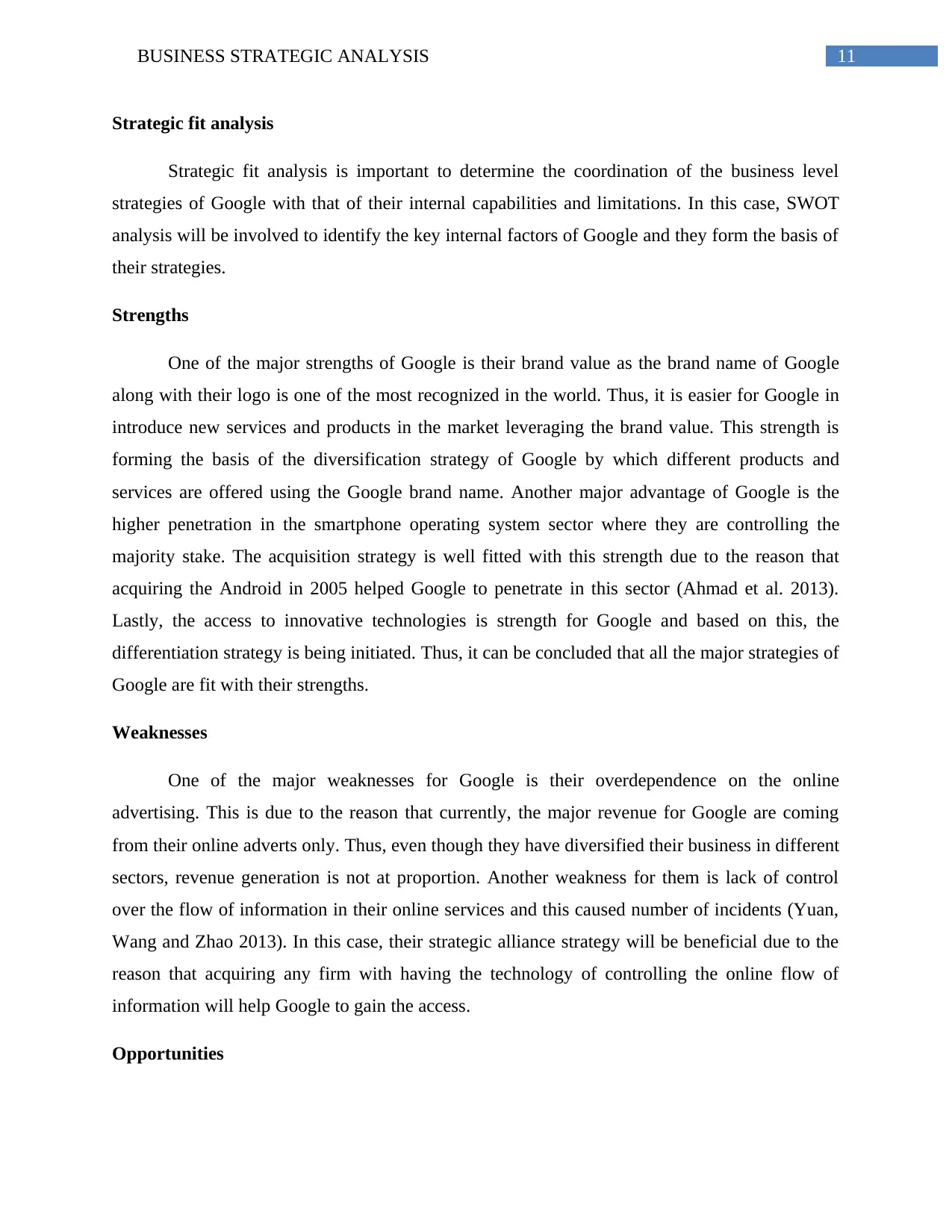
11BUSINESS STRATEGIC ANALYSIS
Strategic fit analysis
Strategic fit analysis is important to determine the coordination of the business level
strategies of Google with that of their internal capabilities and limitations. In this case, SWOT
analysis will be involved to identify the key internal factors of Google and they form the basis of
their strategies.
Strengths
One of the major strengths of Google is their brand value as the brand name of Google
along with their logo is one of the most recognized in the world. Thus, it is easier for Google in
introduce new services and products in the market leveraging the brand value. This strength is
forming the basis of the diversification strategy of Google by which different products and
services are offered using the Google brand name. Another major advantage of Google is the
higher penetration in the smartphone operating system sector where they are controlling the
majority stake. The acquisition strategy is well fitted with this strength due to the reason that
acquiring the Android in 2005 helped Google to penetrate in this sector (Ahmad et al. 2013).
Lastly, the access to innovative technologies is strength for Google and based on this, the
differentiation strategy is being initiated. Thus, it can be concluded that all the major strategies of
Google are fit with their strengths.
Weaknesses
One of the major weaknesses for Google is their overdependence on the online
advertising. This is due to the reason that currently, the major revenue for Google are coming
from their online adverts only. Thus, even though they have diversified their business in different
sectors, revenue generation is not at proportion. Another weakness for them is lack of control
over the flow of information in their online services and this caused number of incidents (Yuan,
Wang and Zhao 2013). In this case, their strategic alliance strategy will be beneficial due to the
reason that acquiring any firm with having the technology of controlling the online flow of
information will help Google to gain the access.
Opportunities
Strategic fit analysis
Strategic fit analysis is important to determine the coordination of the business level
strategies of Google with that of their internal capabilities and limitations. In this case, SWOT
analysis will be involved to identify the key internal factors of Google and they form the basis of
their strategies.
Strengths
One of the major strengths of Google is their brand value as the brand name of Google
along with their logo is one of the most recognized in the world. Thus, it is easier for Google in
introduce new services and products in the market leveraging the brand value. This strength is
forming the basis of the diversification strategy of Google by which different products and
services are offered using the Google brand name. Another major advantage of Google is the
higher penetration in the smartphone operating system sector where they are controlling the
majority stake. The acquisition strategy is well fitted with this strength due to the reason that
acquiring the Android in 2005 helped Google to penetrate in this sector (Ahmad et al. 2013).
Lastly, the access to innovative technologies is strength for Google and based on this, the
differentiation strategy is being initiated. Thus, it can be concluded that all the major strategies of
Google are fit with their strengths.
Weaknesses
One of the major weaknesses for Google is their overdependence on the online
advertising. This is due to the reason that currently, the major revenue for Google are coming
from their online adverts only. Thus, even though they have diversified their business in different
sectors, revenue generation is not at proportion. Another weakness for them is lack of control
over the flow of information in their online services and this caused number of incidents (Yuan,
Wang and Zhao 2013). In this case, their strategic alliance strategy will be beneficial due to the
reason that acquiring any firm with having the technology of controlling the online flow of
information will help Google to gain the access.
Opportunities
⊘ This is a preview!⊘
Do you want full access?
Subscribe today to unlock all pages.

Trusted by 1+ million students worldwide
1 out of 17
Related Documents
Your All-in-One AI-Powered Toolkit for Academic Success.
+13062052269
info@desklib.com
Available 24*7 on WhatsApp / Email
![[object Object]](/_next/static/media/star-bottom.7253800d.svg)
Unlock your academic potential
Copyright © 2020–2025 A2Z Services. All Rights Reserved. Developed and managed by ZUCOL.





